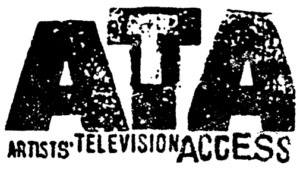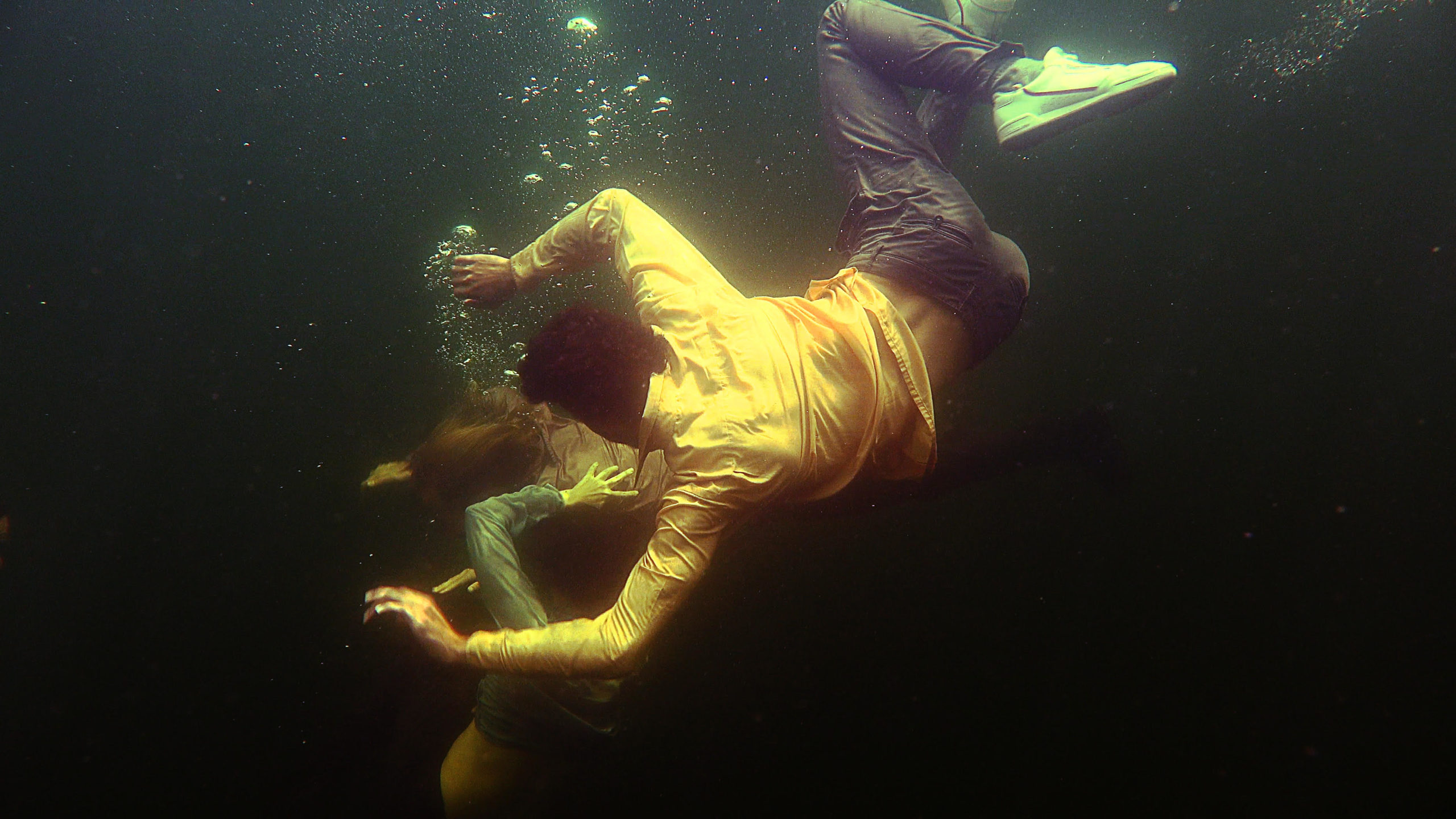 Displaced (2020) by Bettina Hoffmann
Displaced (2020) by Bettina Hoffmann
CROSSROADS 2021 — program 3
ascent into now
Livestream (with live filmmaker intros!) Sunday, September 19 at 7 pm PDT. Watch the livestream here.
Program online September 19–October 21
program community partner: Artist Television Access
Films on liminal states and transitions, on the tensions between being and nothingness, on introspective multiplicity and on the ironies and ecstasies of form and formlessness. Fantasmic contemplations of discarnate limitlessness, the nowness of love and the rawness of abstraction abrade meditations on mortality and corporeality. Spirits vibrate within indeterminate metaphysical lacunae as bodies are bound earthward or are submerged in transitional otherworldly netherlives. We are no longer afraid.
SCREENING: Labor of Love (2020) by Sylvia Schedelbauer; digital video, color, sound, 12 minutes. The Mouth is Still a Wild Door (2020) by Guta Galli & Anne Lesley Selcer; digital video, color, sound, 4 minutes. The Guy on the Bed (2020) by Mike Hoolboom; digital video, b&w, sound, 4 minutes. Black Square (2020) by Peter Burr; digital video, color, sound, 7 minutes. Revenant (2020) by Madison Brookshire & Tashi Wada; digital video, color, sound, 6 minutes. Mustererkenntnis/Pattern Cognition (2019) by Thorston Fleisch; digital video, color, sound, 7 minutes. sub vid heap (2020) by Jennie MaryTai Liu; digital video, color, sound, 7 minutes. Displaced (2020) by Bettina Hoffmann; digital video, color, sound, 7 minutes. Oceano Mare (2020) by Antoinette Zwirchmayr; 16mm screened as digital video, color, sound, 7 minutes.
TRT: 62 minutes
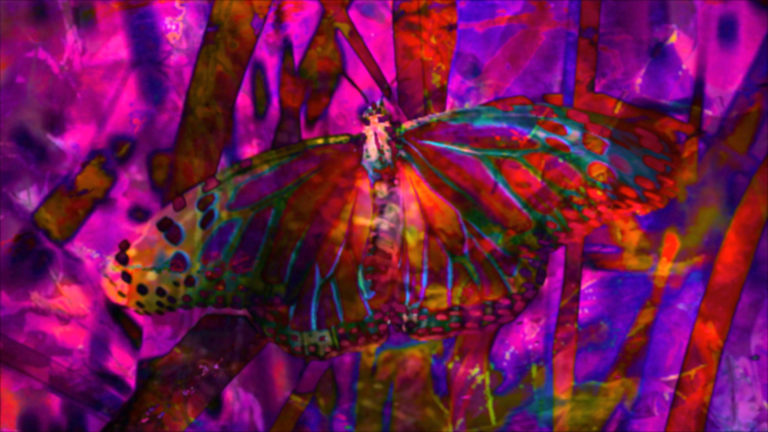
Labor of Love (2020) by Sylvia Schedelbauer
…I resolved to try and visualize a feeling of nowness that unfolds when one is in love. That feeling where the past and futures seem to fall away, when all that matters is every moment that evolves into another, and when that expanded grounding in the present tense seemingly lasts without effort. I didn’t want to narrow things down to one specific experience, or literal story; and I wanted to go beyond one singular notion, or definition. But how can you visualize affective structures that open up in what feel like cascading intervals, like traveling through infinite portals within portals, each opening up new and unexpected spaces? Processes that induce inspiring conversations––creative, intellectual and emotional? Processes that invite possibilities––and allow for change, generosity and growth? (Sylvia Schedelbauer) This film is dedicated to the memory of Paul Clipson. Full artists’ statement here.
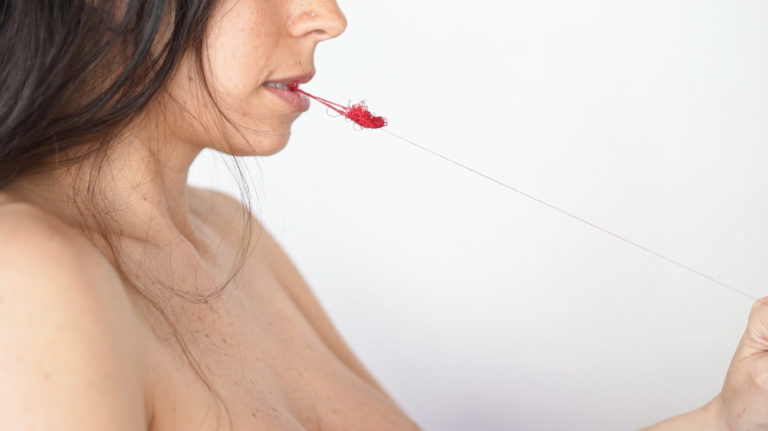
The Mouth is Still a Wild Door (2020) by Guta Galli & Anne Lesley Selcer
Now they preceded the country of their future which contained as yet only the arrow of their mouth whose song had just been born. (René Char) I will recite all the names of the apples in a chain, enchain them, enchant them, bind them, bound them, chant them. The “feral house” of the poem is not a metaphor, it is the term for an abandoned house overtaken by foliage, a domicile lurking, covered, protected, masked, hidden, returned, and wild in a world that was not working. We will not be going back. The unmaking of the future has accelerated. Our entanglement is clearer than ever. Urgent memories of a world before our time, before our time keepers, appear with astonishing presence. They overtake what we thought was the future. It has no name yet, and is growing. (Guta/Selcer)

The Guy on the Bed (2020) by Mike Hoolboom
News from another pandemic, the one that ‘changed everything’ before it fell out of the news cycle and collective memory, except for the newly infected or those who, like myself, managed a new life after death. Based on a text by David Wojnarowicz. (Mike Hoolboom)
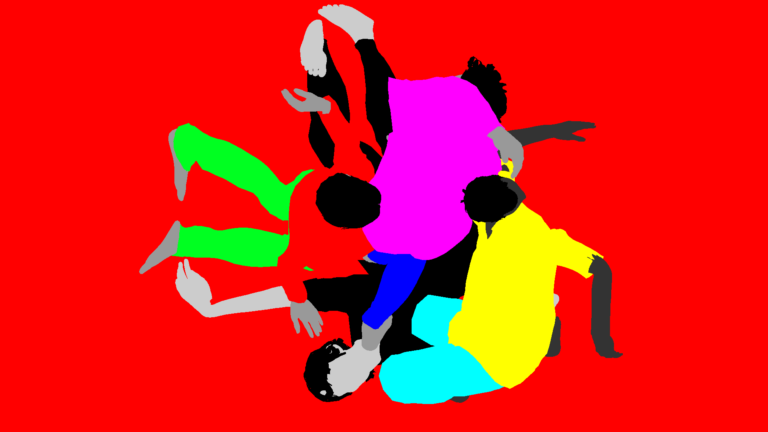
Black Square (2020) by Peter Burr
Black Square is a short film that examines ways we endure contemporary life in the grid. It animates a philosophy of perception through an assault of optical illusions, highlighting limitations of one’s body and mind. An assembly of human figures writhe and squares strobe in rhythm to audio sampled from the opening of the 1965 Op Art exhibition The Responsive Eye. Through the friction of this contrast, a portrait emerges of an anxious divided society pushing at the boundaries of our teetering attention. (Peter Burr)
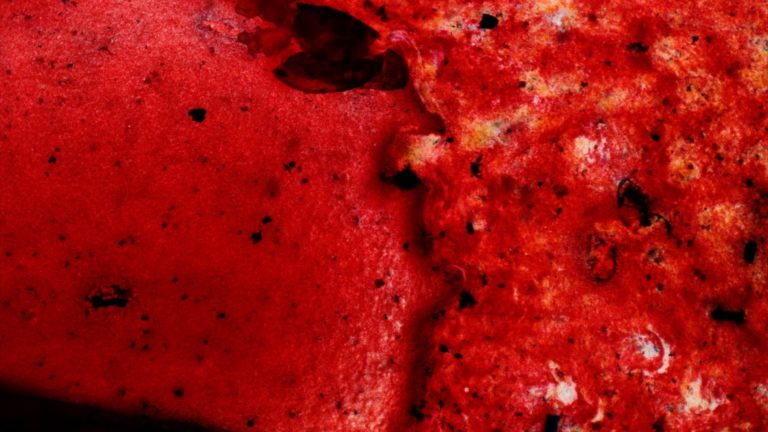
Revenant (2020) by Madison Brookshire & Tashi Wada
Flickering loops of painted film press against and affect Tashi Wada’s score Revenant, performed by Wada and Stephan Mathieu, forming an intense plateau of image and sound. O egg, crisscrossed by axes, crack thy frail case! (Madison Brookshire)
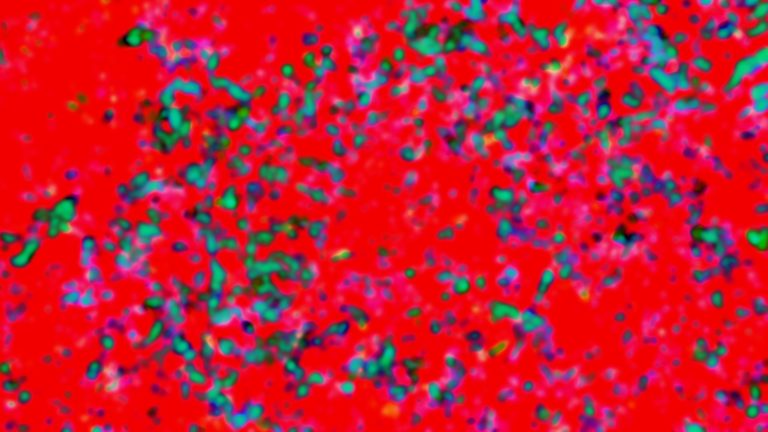
Mustererkenntnis/Pattern Cognition (2019) by Thorsten Fleisch
“When you stare at a screen for long, the screen stares back at you.” It’s late. You’ve been working on those numbers the whole day. The screen in front of you seems to be vibrating. You close your eyes. The after-image on your retina keeps pulsating in iridescent colors. (Thorsten Fleisch)
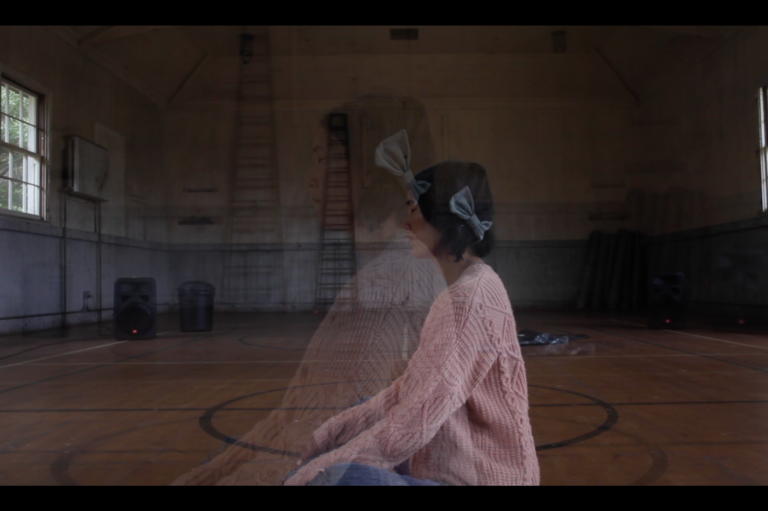
sub vid heap (2018) by Jenny MaryTai Liu
sub vid heap is a visceral and compositional study on domination, shot a year after the birth of a first child. An exhausted ego and a needy id, the sensory and the lingual, desire and duty, horror and humility vie it out in a haunted hall. Captured at Headlands Center for the Arts, screams of a baby are muted out while the process of portraiture claims space for a body craving autonomy. Actions of pushing, vacuuming and rocking conjure the rickety bones of downtrodden ancestors, calling the laboring body from the periphery to the center, moving the rage through the body for joy to inhabit the space it vacates. (Jenny MaryTai Liu)
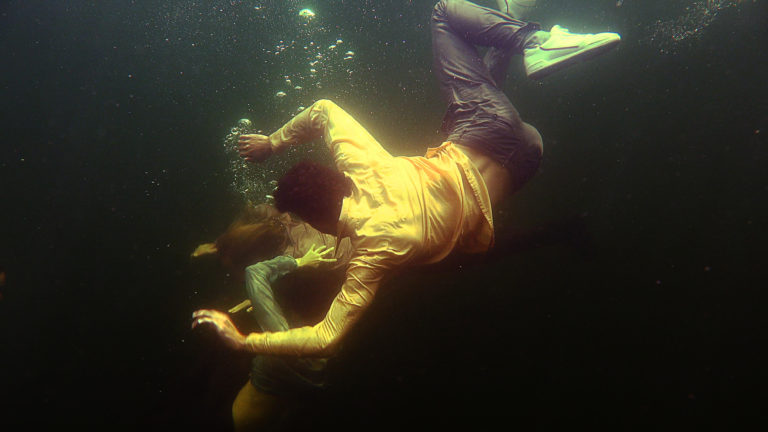
Displaced (2020) by Bettina Hoffmann
People fall into water. Seen from underneath the surface of a lake, those men and women, fully dressed in office attire, move around trying to find orientation while following and bumping into each other. Thrown into this involuntary situation, their movements are at times softly flowing, elegant and caring, but change in the next moment into fighting against each other and for air. They are submerged in an environment which is removed from our daily reality associating sparkling fairy-tale dreams and horrible visions of drowning at the same time. (Bettina Hoffmann)
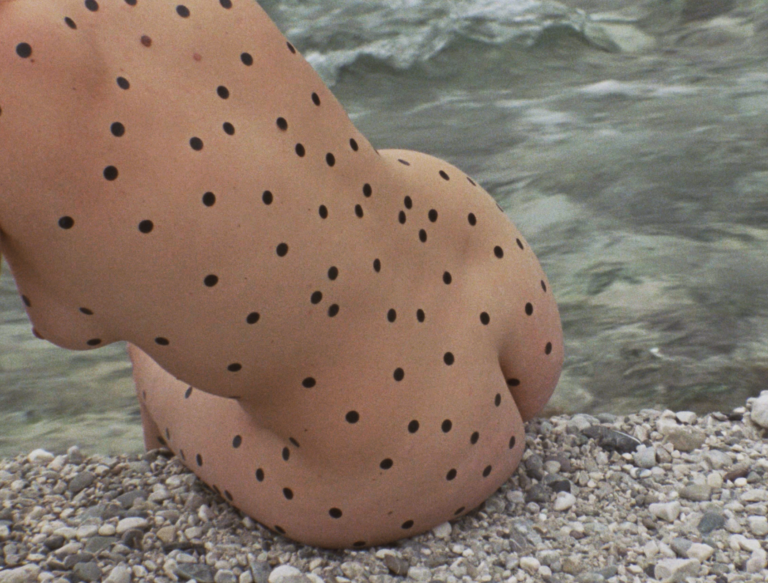
Oceano Mare (2020) by Antoinette Zwirchmayr
Seemingly stranded and enthralled like a somnambulist: a female figure amid a rocky, dried up riverbed. Motionless, exposed and yet turned inward. Now entwined in the branches of the sparse vegetation, now lying on the delicate fissures of the parched ground, from these convergences and from the interplay of images arises a sort of approximation, or analogy. The view of the details, of the particularities and textures of things, widens into the distance; standpoint and perspective shift, whereby the water, the river—and likewise the face of this woman, even with eyes closed—are revealed in succession. (Naoko Kaltschmidt; translation: Geoff Howes) Read the full statement here.
 Sylvia Schedelbauer’s (Germany) films negotiate the space between broader historical narratives and personal, psychological realms mainly through poetic manipulations of found and archival footage.
Sylvia Schedelbauer’s (Germany) films negotiate the space between broader historical narratives and personal, psychological realms mainly through poetic manipulations of found and archival footage.
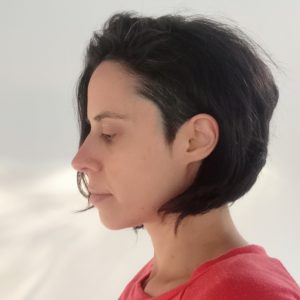 Gutta Galli (Brazil) is an interdisciplinary artist working with performance, video, installation and photography. She holds a postgraduate degree in Photography (FAAP, São Paulo) and an MFA (San Francisco Art Institute). Her feminist researches study the intersections between womanhood, power, race, sexuality and violence. Galli’s last researches use her personal experience as an expatriate artist to make a critical commentary on immigration politics on Trump’s era. In her current work she investigates how neoliberalism and its radical freedom has impacted labor and the contemporary body.
Gutta Galli (Brazil) is an interdisciplinary artist working with performance, video, installation and photography. She holds a postgraduate degree in Photography (FAAP, São Paulo) and an MFA (San Francisco Art Institute). Her feminist researches study the intersections between womanhood, power, race, sexuality and violence. Galli’s last researches use her personal experience as an expatriate artist to make a critical commentary on immigration politics on Trump’s era. In her current work she investigates how neoliberalism and its radical freedom has impacted labor and the contemporary body.
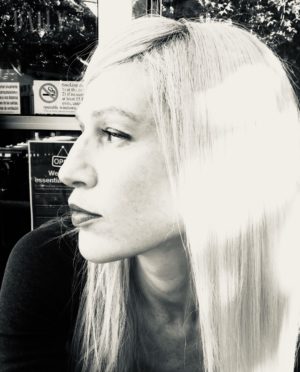 Anne Lesley Selcer (US) is a writer and artist. Her book Sun Cycle, winner of the CSU Poetry Center Book Prize, investigates image, vision, power and gender and is named for the star that makes vision possible. She is also author of Blank Sign Book, a collection of essays about art and politics. She has been commissioned by Artspeak and 2nd Floor Projects for limited edition text pieces, and often writes for art spaces, most recently ON FIGURE/S: Drawing after Bellmer for The Drawing Room, London. Her writing can be found in Prelude, Jacket2, Hyperallergic, Open Space, Art Practical and Fence and has been included in several anthologies. Her language-based video, sound and text pieces have exhibited, screened or been performed at the International Short Film Festival Oberhausen, Berkeley Art Museum/Pacific Film Archive, ProArts, Southern Exposure, Krowswork, Visible Verse, Experiments in Cinema and Artists’ Television Access (among others) and are forthcoming at film festivals in Moscow and Brazil.
Anne Lesley Selcer (US) is a writer and artist. Her book Sun Cycle, winner of the CSU Poetry Center Book Prize, investigates image, vision, power and gender and is named for the star that makes vision possible. She is also author of Blank Sign Book, a collection of essays about art and politics. She has been commissioned by Artspeak and 2nd Floor Projects for limited edition text pieces, and often writes for art spaces, most recently ON FIGURE/S: Drawing after Bellmer for The Drawing Room, London. Her writing can be found in Prelude, Jacket2, Hyperallergic, Open Space, Art Practical and Fence and has been included in several anthologies. Her language-based video, sound and text pieces have exhibited, screened or been performed at the International Short Film Festival Oberhausen, Berkeley Art Museum/Pacific Film Archive, ProArts, Southern Exposure, Krowswork, Visible Verse, Experiments in Cinema and Artists’ Television Access (among others) and are forthcoming at film festivals in Moscow and Brazil.
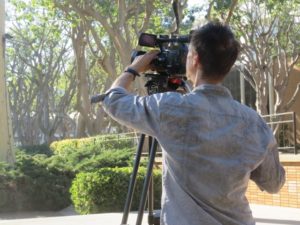 Mike Hoolboom (Canada) began making movies in 1980. Making as practice, a daily application. Ongoing remixology. 100+ movies. Since 2000 a steady drip of bio docs. The animating question of community: How can I help you? Interviews with media artists for 3 decades. 30+ books, written, edited, co-edited. Local ecologies. Volunteerism. Opening the door.
Mike Hoolboom (Canada) began making movies in 1980. Making as practice, a daily application. Ongoing remixology. 100+ movies. Since 2000 a steady drip of bio docs. The animating question of community: How can I help you? Interviews with media artists for 3 decades. 30+ books, written, edited, co-edited. Local ecologies. Volunteerism. Opening the door.
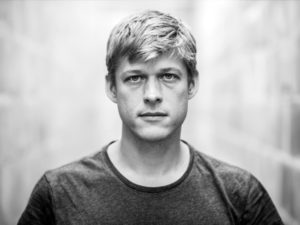 Peter Burr (US) is an artist from Brooklyn NY. A master of computer animation with a gift for creating images and environments that hover on the boundary between abstraction and figuration, Burr has in recent years devoted himself to exploring the concept of an endlessly mutating labyrinth. His practice often engages with tools of the video game industry in the form of immersive cinematic artworks. These pieces have been presented internationally by various institutions including Documenta 14, Athens; MoMA PS1, New York and The Barbican Centre, London. Previously Burr worked under the alias Hooliganship and founded the video label Cartune Xprez through which he produced hundreds of live multimedia exhibitions and touring programs showcasing a multi-generational group of artists at the forefront of experimental animation. His practice has been recognized through grants and awards including a Guggenheim Fellowship, a Creative Capital Grant and a Sundance New Frontier Fellowship.
Peter Burr (US) is an artist from Brooklyn NY. A master of computer animation with a gift for creating images and environments that hover on the boundary between abstraction and figuration, Burr has in recent years devoted himself to exploring the concept of an endlessly mutating labyrinth. His practice often engages with tools of the video game industry in the form of immersive cinematic artworks. These pieces have been presented internationally by various institutions including Documenta 14, Athens; MoMA PS1, New York and The Barbican Centre, London. Previously Burr worked under the alias Hooliganship and founded the video label Cartune Xprez through which he produced hundreds of live multimedia exhibitions and touring programs showcasing a multi-generational group of artists at the forefront of experimental animation. His practice has been recognized through grants and awards including a Guggenheim Fellowship, a Creative Capital Grant and a Sundance New Frontier Fellowship.
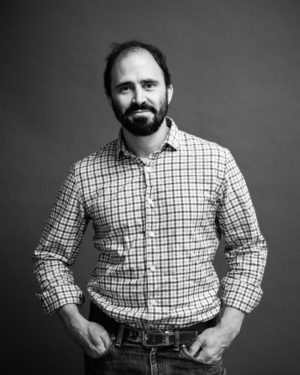 Madison Brookshire (US) lives in Los Angeles, where he makes films, paintings and performances. His projects often invite viewers to an awareness of perceptual processes and the sensuous experience of time. He frequently collaborates with musicians and composers such as LCollective, Mark So, Laura Steenberge and Tashi Wada. He is currently a Lecturer at University of California, Riverside in the departments of Art and the History of Art. Photo by Greg Cohen.
Madison Brookshire (US) lives in Los Angeles, where he makes films, paintings and performances. His projects often invite viewers to an awareness of perceptual processes and the sensuous experience of time. He frequently collaborates with musicians and composers such as LCollective, Mark So, Laura Steenberge and Tashi Wada. He is currently a Lecturer at University of California, Riverside in the departments of Art and the History of Art. Photo by Greg Cohen.
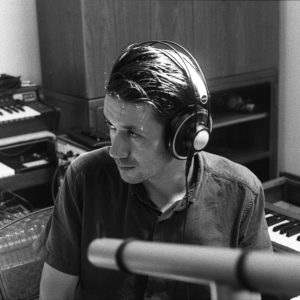 Tashi Wada (US) is a Los Angeles–based composer and performer whose works explore resonance and dissonance through precise tuning and gradual change in pitch. Grounded in a belief that “music should be as direct as possible,” his compositions use apparently simple structures to generate rich and unanticipated perceptual effects. Wada studied composition at CalArts with James Tenney and for many years performed alongside his father, Yoshi Wada. Wada is the founder of the record label Saltern. His most recent album Nue was released by RVNG Intl. Photo by Dicky Bahto.
Tashi Wada (US) is a Los Angeles–based composer and performer whose works explore resonance and dissonance through precise tuning and gradual change in pitch. Grounded in a belief that “music should be as direct as possible,” his compositions use apparently simple structures to generate rich and unanticipated perceptual effects. Wada studied composition at CalArts with James Tenney and for many years performed alongside his father, Yoshi Wada. Wada is the founder of the record label Saltern. His most recent album Nue was released by RVNG Intl. Photo by Dicky Bahto.
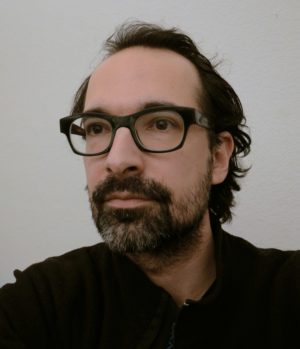 Thorsten Fleisch (Germany) born 1972. First film experiments with his dad’s Super-8 camera when still in school. Studied experimental film with Peter Kubelka at the Städelschule in Frankfurt. His films have received several awards and are shown at festivals worldwide including: New York Film Festival, Ars Electronica, Transmediale, Ottawa International Animation Festival, Clermont-Ferrand International Short Film Festival and International Film Festival Rotterdam. He lives and works in Berlin where he is also involved in theatre projects, creating video games and musical excesses with his band Malende.
Thorsten Fleisch (Germany) born 1972. First film experiments with his dad’s Super-8 camera when still in school. Studied experimental film with Peter Kubelka at the Städelschule in Frankfurt. His films have received several awards and are shown at festivals worldwide including: New York Film Festival, Ars Electronica, Transmediale, Ottawa International Animation Festival, Clermont-Ferrand International Short Film Festival and International Film Festival Rotterdam. He lives and works in Berlin where he is also involved in theatre projects, creating video games and musical excesses with his band Malende.
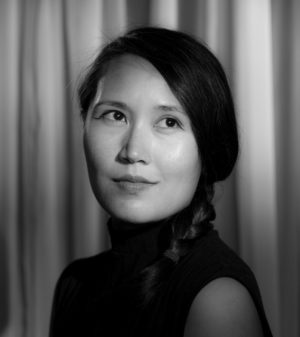 Jennie MaryTai Liu (Hong Kong/US), is an artist working across performance, choreography, video and writing. She has worked in institutions and artist-run spaces including the LACMA, Human Resources, The Mistake Room, Bushwick Starr, HERE Arts Center, Dance Theater Workshop and Incubator Arts Center. She co-founded and edited Riting, an experiment in writing that engages with performance being made now in LA. She is currently organizing a 2022 performance exhibition funded by the Mike Kelley Foundation engaging Los Angeles dance artists to respond to modern dance activity in early 20th century LA. Jennie frequently collaborates as a performer in the work of Big Dance Theater, Adam Linder and Poor Dog Group.
Jennie MaryTai Liu (Hong Kong/US), is an artist working across performance, choreography, video and writing. She has worked in institutions and artist-run spaces including the LACMA, Human Resources, The Mistake Room, Bushwick Starr, HERE Arts Center, Dance Theater Workshop and Incubator Arts Center. She co-founded and edited Riting, an experiment in writing that engages with performance being made now in LA. She is currently organizing a 2022 performance exhibition funded by the Mike Kelley Foundation engaging Los Angeles dance artists to respond to modern dance activity in early 20th century LA. Jennie frequently collaborates as a performer in the work of Big Dance Theater, Adam Linder and Poor Dog Group.
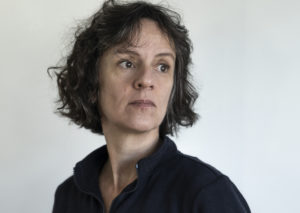 Bettina Hoffmann (Germany/Canada) is an artist originally from Berlin, based in Tiohtià:ke/Montréal, Canada. Hoffmann’s work has been exhibited in Germany, the Netherlands, Austria, United Kingdom, Rumania, South Korea, Japan, USA and Canada. Solo exhibitions include Choreography of Movements, Goethe Institut Montreal, 2019; Touch at Occurrence, 2016; Drain at Oboro, Montreal, 2014; Émile, Art Gallery of Ontario, Toronto, 2009; Décalage at Prefix Institute of Contemporary Art, Toronto; Kristi Engel Gallery, Los Angeles 2008; and Mois de la Photo à Montréal, 2007. Her videos have been presented at film festivals and video art fairs internationally. Her performances have been presented at the Darling Foundry, Tangente + Occurrence in Montreal and several venues in Tokyo. Hoffmann received a Master of Fine Arts degree from Hochschule der Künste, Berlin and attended the California Institute of the Arts and the Rijksakademie van beeldende Kunsten, Amsterdam.
Bettina Hoffmann (Germany/Canada) is an artist originally from Berlin, based in Tiohtià:ke/Montréal, Canada. Hoffmann’s work has been exhibited in Germany, the Netherlands, Austria, United Kingdom, Rumania, South Korea, Japan, USA and Canada. Solo exhibitions include Choreography of Movements, Goethe Institut Montreal, 2019; Touch at Occurrence, 2016; Drain at Oboro, Montreal, 2014; Émile, Art Gallery of Ontario, Toronto, 2009; Décalage at Prefix Institute of Contemporary Art, Toronto; Kristi Engel Gallery, Los Angeles 2008; and Mois de la Photo à Montréal, 2007. Her videos have been presented at film festivals and video art fairs internationally. Her performances have been presented at the Darling Foundry, Tangente + Occurrence in Montreal and several venues in Tokyo. Hoffmann received a Master of Fine Arts degree from Hochschule der Künste, Berlin and attended the California Institute of the Arts and the Rijksakademie van beeldende Kunsten, Amsterdam.
Antoinette Zwirchmayr (Austria). Studied at the Academy of Fine Arts Vienna. Her works have been featured in festivals including Berlinale, Toronto International Film Festival, International Short Film Festival Oberhausen, Indielisboa, Media City Film Festival, Ann Arbor Film Festival and FID Marseille. She has been awarded with the Outstanding Artist Award (BKA 2020), a six month residency in New York (ISCP), the Start-Up Grant for Young Film Artists (Austria 2017), the annual grant for photography (Land Salzburg 2017) Simon S. Filmaward (2016), Kodak Cinematic Vision Award (Ann Arbor Film Festival 2016), among other awards.
